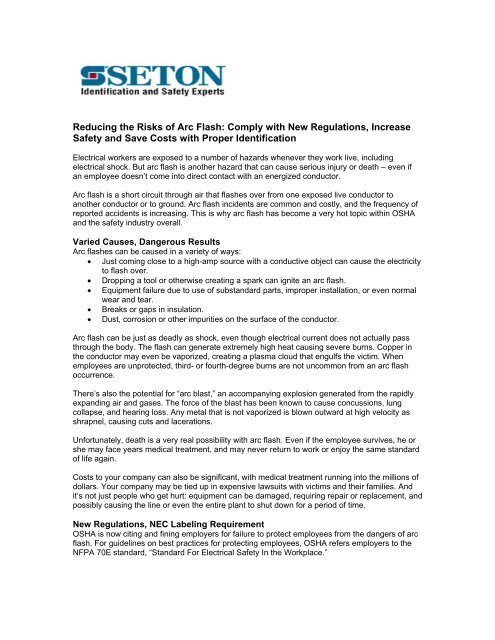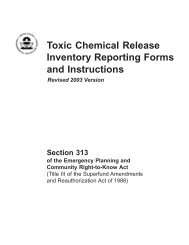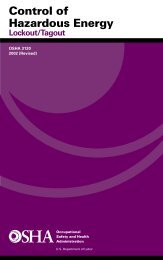Reducing the Risks of Arc Flash with Proper Identification - Seton ...
Reducing the Risks of Arc Flash with Proper Identification - Seton ...
Reducing the Risks of Arc Flash with Proper Identification - Seton ...
You also want an ePaper? Increase the reach of your titles
YUMPU automatically turns print PDFs into web optimized ePapers that Google loves.
<strong>Reducing</strong> <strong>the</strong> <strong>Risks</strong> <strong>of</strong> <strong>Arc</strong> <strong>Flash</strong>: Comply <strong>with</strong> New Regulations, Increase<br />
Safety and Save Costs <strong>with</strong> <strong>Proper</strong> <strong>Identification</strong><br />
Electrical workers are exposed to a number <strong>of</strong> hazards whenever <strong>the</strong>y work live, including<br />
electrical shock. But arc flash is ano<strong>the</strong>r hazard that can cause serious injury or death – even if<br />
an employee doesn’t come into direct contact <strong>with</strong> an energized conductor.<br />
<strong>Arc</strong> flash is a short circuit through air that flashes over from one exposed live conductor to<br />
ano<strong>the</strong>r conductor or to ground. <strong>Arc</strong> flash incidents are common and costly, and <strong>the</strong> frequency <strong>of</strong><br />
reported accidents is increasing. This is why arc flash has become a very hot topic <strong>with</strong>in OSHA<br />
and <strong>the</strong> safety industry overall.<br />
Varied Causes, Dangerous Results<br />
<strong>Arc</strong> flashes can be caused in a variety <strong>of</strong> ways:<br />
• Just coming close to a high-amp source <strong>with</strong> a conductive object can cause <strong>the</strong> electricity<br />
to flash over.<br />
• Dropping a tool or o<strong>the</strong>rwise creating a spark can ignite an arc flash.<br />
• Equipment failure due to use <strong>of</strong> substandard parts, improper installation, or even normal<br />
wear and tear.<br />
• Breaks or gaps in insulation.<br />
• Dust, corrosion or o<strong>the</strong>r impurities on <strong>the</strong> surface <strong>of</strong> <strong>the</strong> conductor.<br />
<strong>Arc</strong> flash can be just as deadly as shock, even though electrical current does not actually pass<br />
through <strong>the</strong> body. The flash can generate extremely high heat causing severe burns. Copper in<br />
<strong>the</strong> conductor may even be vaporized, creating a plasma cloud that engulfs <strong>the</strong> victim. When<br />
employees are unprotected, third- or fourth-degree burns are not uncommon from an arc flash<br />
occurrence.<br />
There’s also <strong>the</strong> potential for “arc blast,” an accompanying explosion generated from <strong>the</strong> rapidly<br />
expanding air and gases. The force <strong>of</strong> <strong>the</strong> blast has been known to cause concussions, lung<br />
collapse, and hearing loss. Any metal that is not vaporized is blown outward at high velocity as<br />
shrapnel, causing cuts and lacerations.<br />
Unfortunately, death is a very real possibility <strong>with</strong> arc flash. Even if <strong>the</strong> employee survives, he or<br />
she may face years medical treatment, and may never return to work or enjoy <strong>the</strong> same standard<br />
<strong>of</strong> life again.<br />
Costs to your company can also be significant, <strong>with</strong> medical treatment running into <strong>the</strong> millions <strong>of</strong><br />
dollars. Your company may be tied up in expensive lawsuits <strong>with</strong> victims and <strong>the</strong>ir families. And<br />
it’s not just people who get hurt: equipment can be damaged, requiring repair or replacement, and<br />
possibly causing <strong>the</strong> line or even <strong>the</strong> entire plant to shut down for a period <strong>of</strong> time.<br />
New Regulations, NEC Labeling Requirement<br />
OSHA is now citing and fining employers for failure to protect employees from <strong>the</strong> dangers <strong>of</strong> arc<br />
flash. For guidelines on best practices for protecting employees, OSHA refers employers to <strong>the</strong><br />
NFPA 70E standard, “Standard For Electrical Safety In <strong>the</strong> Workplace.”
NFPA 70E instructs employers to conduct an arc flash analysis to determine <strong>the</strong> amount <strong>of</strong><br />
<strong>the</strong>rmal energy that could be generated in an arc flash incident. The information is <strong>the</strong>n used to<br />
define a flash protection boundary around <strong>the</strong> potential source, and to determine <strong>the</strong> level <strong>of</strong><br />
flame-resistant apparel and o<strong>the</strong>r personal protection equipment required when employees cross<br />
<strong>the</strong> boundary while <strong>the</strong>y work on or near exposed live parts.<br />
In addition, <strong>the</strong> National Electric Code® (known as NFPA 70, which is different than NFPA 70E)<br />
added a requirement in 2002 mandating that potential arc flash hazards be labeled to warn <strong>of</strong> <strong>the</strong><br />
hazard. The requirement, covered under Article 110.16, was updated and expanded in <strong>the</strong> 2005<br />
version <strong>of</strong> <strong>the</strong> NEC.<br />
What Needs to be Labeled, By Whom<br />
The NEC states that any <strong>of</strong> <strong>the</strong> following types <strong>of</strong> electrical equipment located in manufacturing<br />
and commercial establishments (o<strong>the</strong>r than dwelling occupancies) must be field marked <strong>with</strong> a<br />
warning label if subject to examination, adjustment, service or maintenance while energized:<br />
• Switchboards<br />
• Panelboards<br />
• Industrial control panels<br />
• Meter socket enclosures<br />
• Motor control centers<br />
The labeling requirement is <strong>the</strong> responsibility <strong>of</strong> <strong>the</strong> employer, not <strong>the</strong> manufacturer or installer <strong>of</strong><br />
<strong>the</strong> equipment.<br />
Since <strong>the</strong> provision took effect in 2002, equipment installed before <strong>the</strong>n technically does not need<br />
to be labeled. However, labeling does need to be applied if <strong>the</strong> equipment is ever modified or<br />
upgraded in any way. At least one OSHA representative has stated that he considers changing a<br />
fuse or a breaker to be a modification that would require labeling. More importantly, from a safety<br />
standpoint, <strong>the</strong> hazard is <strong>the</strong> same regardless <strong>of</strong> when <strong>the</strong> equipment was installed.<br />
Consequently, most employers are simply labeling all <strong>the</strong> appropriate equipment, regardless <strong>of</strong><br />
when it was installed.<br />
Many employers are also labeling bus ducts and o<strong>the</strong>r electrical equipment not specifically called<br />
out in 110.16. Again, <strong>the</strong> logic is <strong>the</strong> same. If live electrical work may be performed on <strong>the</strong>se<br />
systems, <strong>the</strong> risk <strong>of</strong> accident and injury exists. Clearly it is better to properly warn workers <strong>of</strong> <strong>the</strong><br />
hazard.<br />
The NEC requirement states that <strong>the</strong> marking must be located so that it’s clearly visible to<br />
qualified persons before <strong>the</strong>y begin work. Typically, <strong>the</strong> label is placed outside <strong>the</strong> panel or<br />
enclosure door. In some cases, however, companies choose to put <strong>the</strong> label inside <strong>the</strong> door (e.g.,<br />
to protect it from harsh environments), but this should only be done if <strong>the</strong> door must first be<br />
opened (allowing <strong>the</strong> label to be seen) before <strong>the</strong> panel face or enclosure can be removed. The<br />
key point is that <strong>the</strong> label be easily noticeable by workers before <strong>the</strong>y may be exposed to any<br />
potentially dangerous live parts.<br />
What Needs to Appear on <strong>the</strong> Label?<br />
The current NEC requirement states only that <strong>the</strong> label must warn <strong>of</strong> <strong>the</strong> potential arc flash<br />
hazard.<br />
A fine-print, information-only note in <strong>the</strong> NEC requirement refers <strong>the</strong> reader to ANSIZ535.4-1998,<br />
Product Safety Signs and Labels, for guidelines on <strong>the</strong> design <strong>of</strong> warning labels. Thus, it is<br />
recommended that <strong>the</strong> header, message and pictogram, if used, be formatted according to <strong>the</strong><br />
ANSI standard.
The NEC does not specify whe<strong>the</strong>r to use a Danger or Warning header, leaving this up to <strong>the</strong><br />
employer. Some companies use Warning, some Danger. Some use Danger when <strong>the</strong> voltage is<br />
over 600v, and Warning when it is under that threshold. This should be decided by <strong>the</strong> employer<br />
and used consistently throughout <strong>the</strong> plant.<br />
In addition to warning <strong>of</strong> an arc flash hazard, most arc flash labels at least instruct employees to<br />
wear <strong>the</strong> proper personal protection equipment. Many also take <strong>the</strong> opportunity also warn <strong>of</strong><br />
electrical shock. The 2” x 4” <strong>Seton</strong> label shown below meets all NEC requirements and is<br />
available in 10-packs or economical 100-label rolls.<br />
2” x 4” generic arc flash label<br />
Some companies prefer to include additional information identifying 1) when <strong>the</strong> hazard is present<br />
and 2) <strong>the</strong> potential magnitude <strong>of</strong> risk to <strong>the</strong> employee. Although not required, <strong>the</strong>y may also<br />
choose to include a symbol or pictogram. There are no standards for how an arc flash pictogram<br />
should appear. The examples below show <strong>the</strong> pictogram used by <strong>Seton</strong> on its arc flash labels.<br />
3.5” x 5” arc flash labels <strong>with</strong> pictogram<br />
Labels must be able to <strong>with</strong>stand <strong>the</strong>ir usage environment. This means that <strong>the</strong> print should not<br />
fade, and adhesive should be aggressive enough to avoid peeling. The arc flash labels above are<br />
printed on a durable polyester base that is over-laminated to protect <strong>the</strong> text and graphics. The<br />
back <strong>of</strong> <strong>the</strong> labels also employ an acrylic adhesive, which allows <strong>the</strong> labels to be securely and<br />
permanently affixed to a wide range <strong>of</strong> surfaces.<br />
Write-on Labels<br />
Some employers are going a step fur<strong>the</strong>r by giving employees even more information on what<br />
<strong>the</strong>y should do to protect <strong>the</strong>mselves. Rumors have hinted that future updates <strong>of</strong> <strong>the</strong> NEC will<br />
require this type <strong>of</strong> additional information. So, many employers are going <strong>the</strong> extra mile now to<br />
avoid having to re-label later, and also to gain <strong>the</strong> safety advantages. Best practices and common<br />
sense dictate that you not only inform employees <strong>of</strong> <strong>the</strong> hazard, but also clearly explain what <strong>the</strong>y<br />
should do to protect <strong>the</strong>mselves from <strong>the</strong> hazard.
Typically <strong>the</strong>se labels are customized for specific pieces <strong>of</strong> equipment, and will note <strong>the</strong> arc flash<br />
protection boundary and <strong>the</strong> incident energy, typically specified in cal/cm². The labels usually note<br />
<strong>the</strong> type <strong>of</strong> flame-resistant apparel and o<strong>the</strong>r personal protection equipment (such as hard hat,<br />
face shield, lea<strong>the</strong>r gloves, etc.) required.<br />
<strong>Seton</strong> provides several stock labels that can display this information. The vinyl checkbox label<br />
shown below can be easily written on <strong>with</strong> pen or marker. You can <strong>the</strong>n apply an over-laminate to<br />
protect <strong>the</strong> printing from harsh environmental conditions.<br />
As long as you’re providing employees <strong>with</strong> information on arc flash hazards, it may make sense<br />
for <strong>the</strong> label to also display similar information to help protect against shock. You can include<br />
information such as voltage, approach boundaries, and insulated glove and tool classes on <strong>the</strong><br />
label.<br />
Write-on arc flash labels <strong>with</strong> checkboxes<br />
<strong>Seton</strong> also provides arc flash labels preprinted <strong>with</strong> <strong>the</strong> hazard category and PPE requirements,<br />
relieving <strong>the</strong> employer from having to hand-write this information. As <strong>with</strong> <strong>the</strong> checkbox labels, a<br />
version that covers both arc flash and shock hazards is available.<br />
©2006 Brady Corporation
















